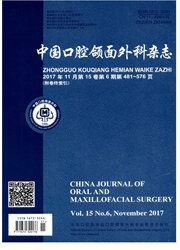

 中文摘要:
中文摘要:
目的 :评价计算机辅助技术(computer-assisted surgical simulation,CASS)在肋骨软骨移植(costochondral graft,CCG)重建颞下颌关节中的应用效果。方法:选取2013年11月—2015年3月进行CCG的患者。术前通过拍摄颅颌面CT和胸部CT,将其导入到Mimics软件,进行虚拟定位和规划截骨,用于指导软骨的选择和放置以及手术过程中髁突和下颌支的修整。术后应用Mimics软件测量和计算肋骨移植的偏差。结果:7例(9侧)利用CASS进行CCG的患者被纳入研究,其中男2例,女5例;平均年龄30.2岁(21-45岁)。单侧5例,双侧2例。7侧关节重建选择第6肋骨,2侧关节重建选择第7肋骨。所有置换肋骨在手术中均未进行修整或弯曲。术后CT扫描显示所有患者通过CASS进行CCG,成功重建了下颌髁突。所有患者的肋骨-肋软骨均恰好位于关节窝内,咬合关系良好,无需颌间牵引。共植入46颗钛钉,均位于下牙槽神经血管束后。16颗钛钉在下颌支内侧面暴露,平均暴露长度为0.7 mm(0.2-1.3 mm)。合并后的CT表明,与术前设计的位置相比,CCG的末端相对倾斜且靠前,倾斜度的平均值为5.4°(1.7-7.3°)。结论:CASS能够精确选择合适的肋骨,匹配下颌支的外侧面,引导截骨和修整,帮助肋骨固定在预期位置,避免对下牙槽神经血管束的损伤。
 英文摘要:
英文摘要:
PURPOSE: This study was to introduce the application of computer-assisted surgical simulation (CASS) for temporomandibular joint (TMJ) reconstruction with costochondral graft (CCG). METHODS: Patients who underwent TMJ reconstruction with CCG from November 2013 to March 2015 were included in this study. Cranio-maxillofacial and chest CT scans were performed and imported into the Mimics software for virtual positioning and osteotomy planning to guide the selection and placement of the rib and bone trimming of the condyle and ramus before surgery. The implanted deviation of the rib was measured or calculated in Mimics software. RESULTS: Seven patients (9 joints) who underwent CCG utilizing CASS were included. There were 5 females and 2 males with a mean age of 30.2 years (range, 21 to 45 years). There were 5 patients with unilateral joints reconstruction and 2 patients with bilateral joints reconstruction. In 7 joint reconstructions, the 6th rib was selected, while the 7th rib was selected in 2 joints. All the grafted ribs were not trimmed or contoured intraoperatively. Postoperative CT scans indicated that all patients had successful reconstruction of the mandibular condyle with CCG using CASS. 46 titanium screws in total were implanted and located behind the inferior alveolar neurovascular bundle. There were 16 titanium screws protruding from the medial surface of the ramus, and the mean exposed length was 0.7 mm (range, 0.2 to 1.3 mm). The merged CT scans indicated that the distal end of the CCG was implanted obliquely and anteriorly compared with the predesigned positions, and the mean deviated degree was 5.4°(range, 1.7 to 7.3°). CONCLUSIONS: CASS is an accurate method to select a suitable rib (usually the 6th and 7th) matching with the TMJ anatomy and avoid the blindness of CCG.
 同期刊论文项目
同期刊论文项目
 同项目期刊论文
同项目期刊论文
 期刊信息
期刊信息
